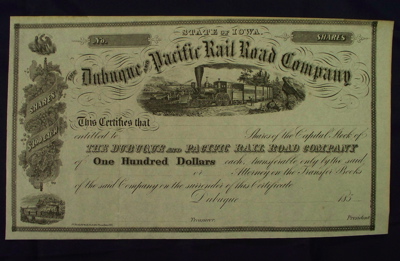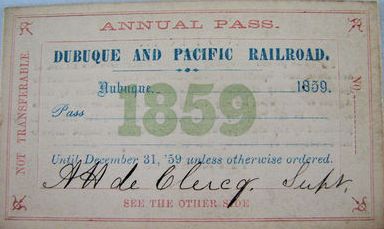Encyclopedia Dubuque
"Encyclopedia Dubuque is the online authority for all things Dubuque, written by the people who know the city best.”
Marshall Cohen—researcher and producer, CNN
Affiliated with the Local History Network of the State Historical Society of Iowa, and the Iowa Museum Association.
DUBUQUE AND PACIFIC RAILROAD
DUBUQUE AND PACIFIC RAILROAD COMPANY.
In 1851 Iowa's senators, George Wallace. JONES and Augustus Dodge proved instrumental in getting the Illinois Central to extend its line from Galena, Illinois to Dunleith (East Dubuque), Illinois. With that assured, Jones, Platt SMITH, Caleb H. BOOTH, Jesse P. FARLEY, Edward Slossan and Judge John J. Dyer formed the Dubuque and Pacific Rail Road in 1853. At the time of its organization, there was not even one mile of railroad constructed in Iowa.
Financial problems delayed the beginning of construction of the line until 1855. It was not until May 1857 that the railroad reached Dyersville. The trip from Dubuque took three hours. Construction was extended to Earlville until work was stopped because of poor credit, lack of a western terminus, and a weak economy.
In the summer of 1859, construction resumed under John Edgar Thompson, builder of the Pennsylvania Railroad. The line reached Independence in December and by March 1860 the western border of Buchanan County. A station was constructed named Jesup after Morris K. Jesup, a financial backer and later president of the railroad. Holding many of the bonds in default, Jesup forced the railroad into receivership. It was reorganized as the DUBUQUE AND SIOUX CITY RAILROAD.
Dubuque & Pacific Railroad Company currency was issued. Notes were signed by James M. McKinlay, secretary in 1858. His signature is also found in the same capacity on the Dubuque and Sioux City Railroad notes issued in 1861. Platt Meith, vice president, was the other signer.
Information provided by Iowa: Obsolete Notes and Scrip by Dean G. Oakes



